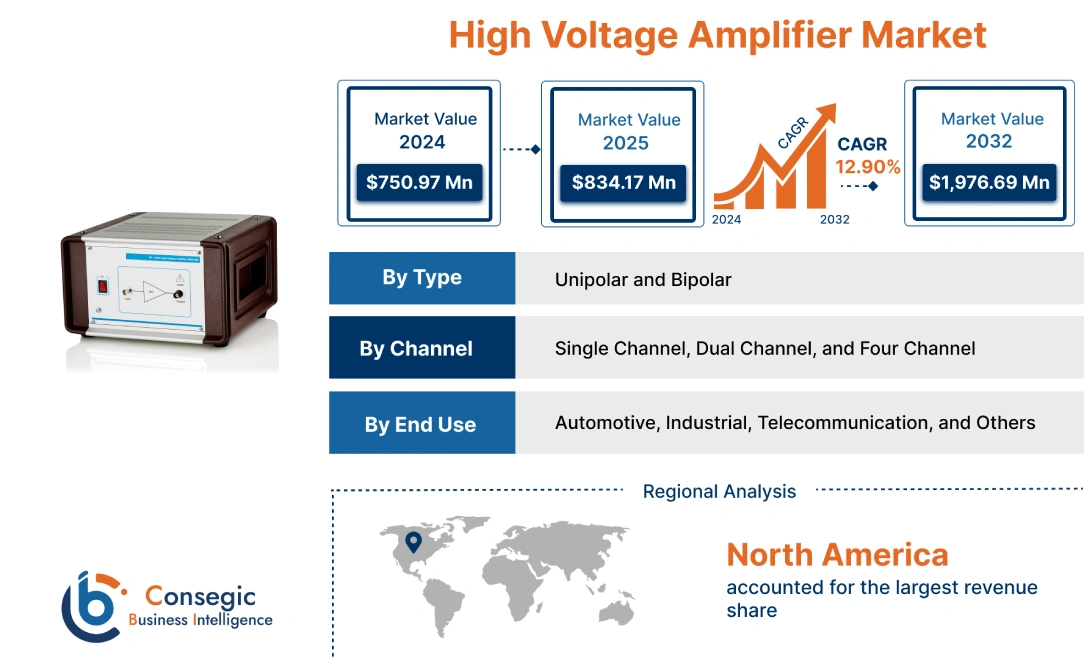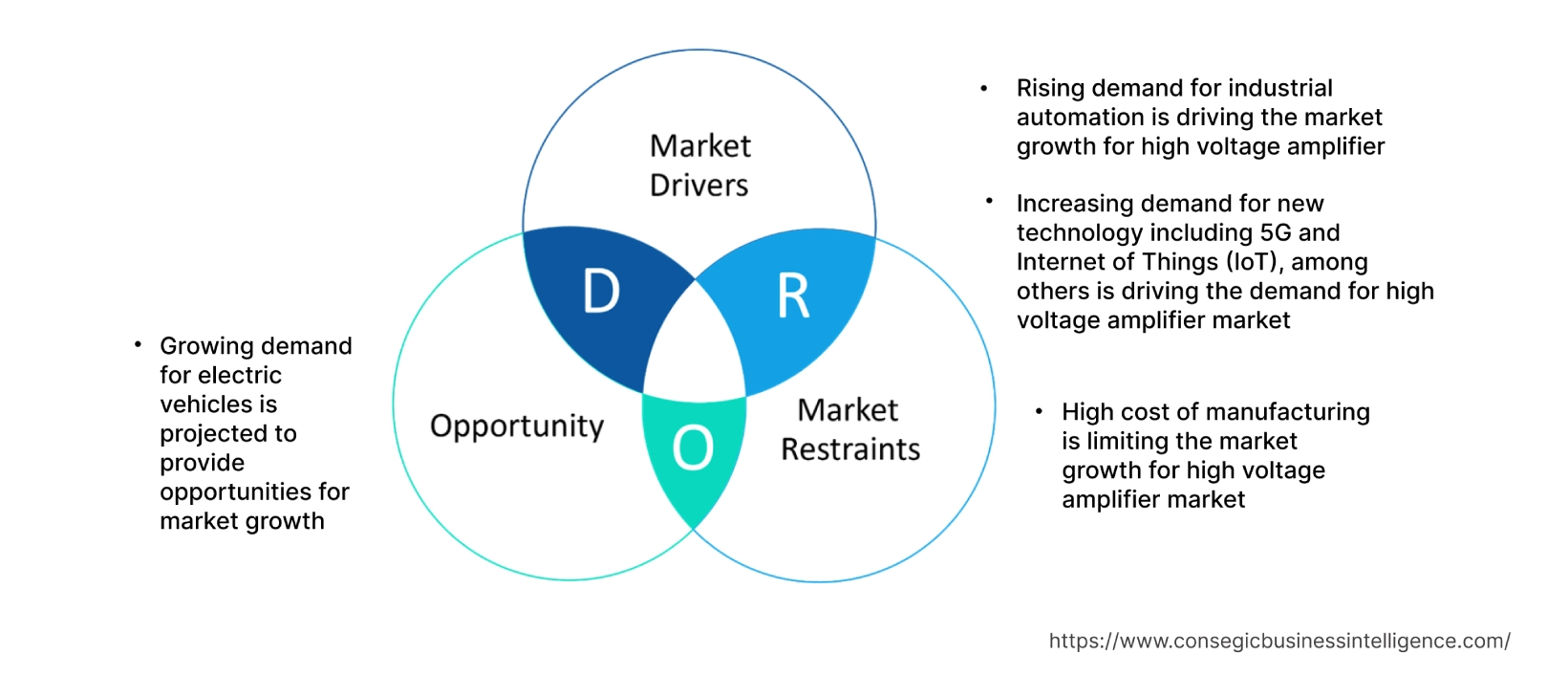- Summary
- Table Of Content
- Methodology
High Voltage Amplifier Market Size :
High Voltage Amplifier Market size is estimated to reach over USD 1,976.69 Million by 2032 from a value of USD 750.97 Million in 2024 and is projected to grow by USD 834.17 Million in 2025, growing at a CAGR of 12.9 % from 2025 to 2032.
High Voltage Amplifier Market Scope & Overview:
High voltage amplifier is a device utilized for voltage signal amplification. The device is designed to provide higher voltage output that often underlies within the voltage range greater than 10V and exceeds 100V or more. Moreover, in order to amplify low input signals such as below 5V, high voltage amplifiers are used that automatically amplify the signals and share a higher output voltage signal. The key applications of high voltage amplifiers include the piezoelectric driver amplifier, general purpose lab amplifier, MEMS, power ripple tests, and relay testing, among others.
High Voltage Amplifier Market Insights :
Key Drivers :
Rising demand for industrial automation is driving the market growth for high voltage amplifier
The industrial automation industry has wide acceptance of high-voltage amplifiers owing to their application in piezoelectric stack actuators. Piezoelectric stack actuators are mainly precision actuators manufactured of ceramic, that are being employed to convert electrical energy into mechanical energy. These actuators are utilized for powerful actuation in a wide application of industrial applications. In addition, major applications of high voltage amplifiers for applied piezoelectric effect include scanning probe microscopies, robotics, and industrial precision positioning system, among others tends to drive the market growth. Therefore, high-voltage amplifiers are used to achieve the performance of piezoelectric actuators.
Moreover, industrial robots are highly in demand for business segments including warehouses, factories, and industries. Industrial robots are designed for attaining powerful activities are include operational-related functions such as arc welding, spot welding, loading, and unloading, among others. The aforementioned operation requires high power for operation and the devices need to rely on high voltage output to function. Further, industrial robots help in reducing industrial waste and minimize the overall cost. Further, industrial robots are consistent in performance and require minimal instructions from humans to maintain accuracy.
For instance, according to Association for Advancing Automation, manufacturers in North America bought 44,196 robots in 2022 for an automation process. The requirement for industrial robots seems to have grown by 18% in comparison to the previous year. Accordingly, the growing requirement for industrial robots in industrial automation processes is boosting the demand for high voltage amplifiers.
Increasing demand for new technology including 5G and Internet of Things (IoT), among others is driving the demand for high voltage amplifier market
The telecommunication sector is rapidly boosting owing to the increasing adoption of 5G to improve low latency and reduce energy usage to connect individual and different business models. The key factor attributing to the growth of telecommunication sectors is due to increased demand for faster network connectivity with respect to current 4G infrastructure. In addition, 5G telecommunication sector requires high signal amplification for signals to travel over longer distances which is ultimately driving the demand for high voltage amplifier market. Moreover, the adoption of 5G by enterprises is boosting the demand for Internet of Things (IoT) and cloud-based solutions which require high amplification devices ultimately promoting the market growth of high voltage amplifiers market.
Furthermore, IoT-based devices are dependent on cloud-based services, whereas cloud-based services are dedicated to local servers and high-end computing devices. Accordingly, the advent of technology employing the application of IoT and 5G services is boosting the market growth of high voltage amplifier market.
Key Restraints :
High cost of manufacturing is limiting the market growth for high voltage amplifier market
High voltage amplifier is expensive owing to factors such as complex design, expensive components, and critical manufacturing processes, among others restraining the market growth. Since high voltage amplifiers are able to withstand higher voltage without breakdown in comparison to low voltage amplifiers tend to be expensive. In addition, high voltage amplifiers require more complex design and engineering than low-voltage amplifiers owing to their withstanding nature of overheating and noise. Moreover, high voltage amplifier complex design requires a more precise assembly process which in turn makes the manufacturing process more difficult. Furthermore, the severity of maintenance of amplifiers has led to a slow growth rate of high voltage amplifier market.
Future Opportunities :
Growing demand for electric vehicles is projected to provide opportunities for market growth
High voltage amplifiers have multiple applications in different electronic segments of electric vehicles including power systems, regenerative braking systems, and power steering systems, among others. Key factors attributing to the demand for high voltage amplifiers for electric vehicle segment are the requirement for high voltage for various components of a vehicle. In addition, high voltage amplifiers are used to control the power current in the electric vehicle power system. The aforementioned amplifiers are used to boost the voltage of the battery in order to control the power of electric motor and to charge the battery.
Moreover, in hybrid electric vehicles (HEV), high voltage amplifiers are used in power systems to control the power flow between the internal combustion engine and electric motor. Further, owing to the increasing demand for electric vehicles to counter greenhouse gas emissions and the motive to reach NetZero is expected to boost the market growth of high voltage amplifier market during the forecast period.
For instance, Microchip Technology Inc. has introduced an automotive grade Quad 250V high voltage amplifier array namely HV56264 specifically designed for the automotive segment.
High Voltage Amplifier Market Report Insights :
| Report Attributes | Report Details |
| Study Timeline | 2019-2032 |
| Market Size in 2032 | USD 1,976.69 Million |
| CAGR (2025-2032) | 12.90% |
| By Type | Unipolar and Bipolar |
| By Channel | Single Channel, Dual Channel, and Four Channel |
| By End Use | Automotive, Industrial, Telecommunication, and Others |
| By Region | North America, Europe, Asia-Pacific, Latin America, and Middle East & Africa |
| Key Players | Analog Technologies, Inc., Analog Devices, Inc., Microchip Technology Inc., Nisshinbo Micro Devices Inc., STMicroelectronics, Texas Instruments, hivolt.de GmbH & Co. KG, Jiangsu Runic Technology Co., Ltd., Apex Microtechnology, Inc., Tabor Electronics Ltd., Acquitek |
High Voltage Amplifier Market Segmental Analysis :
By Type :
Based on the type, the market is bifurcated into unipolar and bipolar. Bipolar is accounted to generate the largest market share in the year 2024. A bipolar high voltage amplifier is an amplifier that outputs both positive and negative voltages. The key factors attributing to the growth of bipolar high voltage amplifiers are due to their wider applications in different sectors including automotive, telecommunication, and industrial, among others. Owing to their growing requirement in the aforementioned field and their ability to amplify both positive and negative voltages is driving its market growth. In the field of automotive, bipolar high voltage amplifiers have applications in audio amplifiers, being used to amplify the signals generated from the source.
For instance, Advanced Energy has launched Trek 623B, a high voltage amplifier for precise control of bipolar output voltages for low-noise operations.
Furthermore, the bipolar type of high voltage amplifier segment is also anticipated to grow at the fastest growth rate during the forecast period owing to factors including versatility, reliability, and efficiency. Bipolar amplifiers are more efficient and are able to amplify a signal with less power consumption. Moreover, the feature is important in applications where power consumption is a concern, such as portable devices. Thus, the advent of technology has been boosting the demand for portable devices and is projected to have demand during the forecast period.
By Channel :
Based on the channel, the market is segmented into single channel, dual channel, and four channels. The single channel high voltage amplifiers segment is accounted to generate the largest market share in the year 2024. Single channel voltage amplifiers are more popular owing to their wide acceptance in commercial applications. A single channel high voltage amplifier is known as an amplifier that amplifies a single signal and has specified applications. Considering its application in consumer electronics, an audio amplifier needs to amplify the signal from the microphone, so a single channel amplifier is employed.
For instance, Aimil Ltd. has launched single channel high voltage linear amplifiers, namely pendulum. The device is meant to be employed for applications in sectors including R&D labs, components manufacturing industries, and research institutes.
Moreover, the dual channel high voltage amplifiers segment is expected to grow at the fastest rate during the forecast period. Dual channel amplifiers have the features to amplify two signals simultaneously. For instance, a medical imaging system needs to amplify the signals from two different sensors at a single point. The key applications of dual channel high voltage amplifiers include data acquisition systems, medical imaging systems, radar systems, and industrial control systems. Accordingly, owing to the rising demand for advanced electronics from commercial sectors will promote the market growth of high voltage amplifiers during the forecast period.
By End-User :
Based on the end use, the market is segmented into automotive, industrial, telecommunication, and others. The automotive segment accounted for the largest market share of 42.5% in 2024. The key factors driving the growth of this segment are the rising demand for electric vehicles (EVs) and hybrid electric vehicles (HEVs) that utilize high voltage amplifiers to control the high voltage systems. In addition, components including inverters, chargers, power converters, power steering, and others utilize high voltage amplifiers to control the flow of voltage.
Furthermore, the telecommunication segment is expected to grow at the fastest rate during the forecast period. The adoption of 5G connectivity is expected to be a major driver of growth in the telecommunications segment. 5G is the next generation of cellular technology that will provide faster speeds and lower latency than previous generations i.e., 4G. The offerings by the telecommunication sector by means of 5G connectivity will prove to be an ideal solution for a variety of applications including streaming video, virtual reality, and self-driving cars. The growing need for robust telecommunications infrastructure is also being driven by the increasing use of smartphones and handheld devices among personal and commercial segments. Therefore, owing to the aforementioned factors, telecommunication sector will promote the growth of high voltage amplifiers during the forecast period.
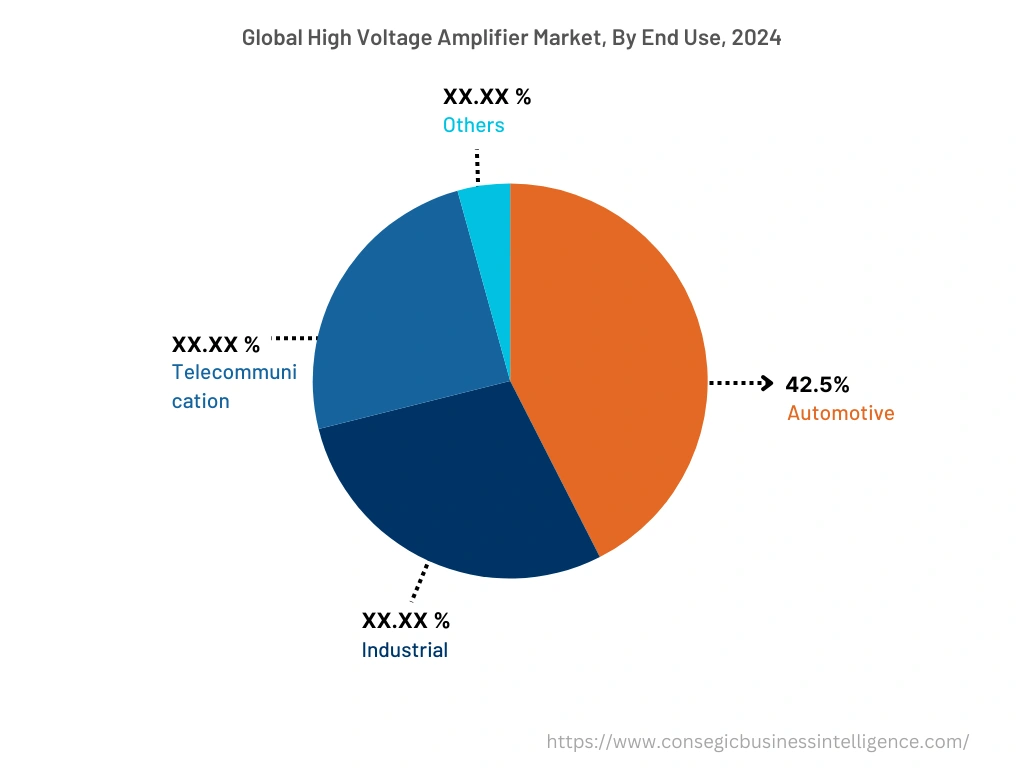
By Region :
The regional segment includes North America, Europe, Asia Pacific, Middle East and Africa, and Latin America.
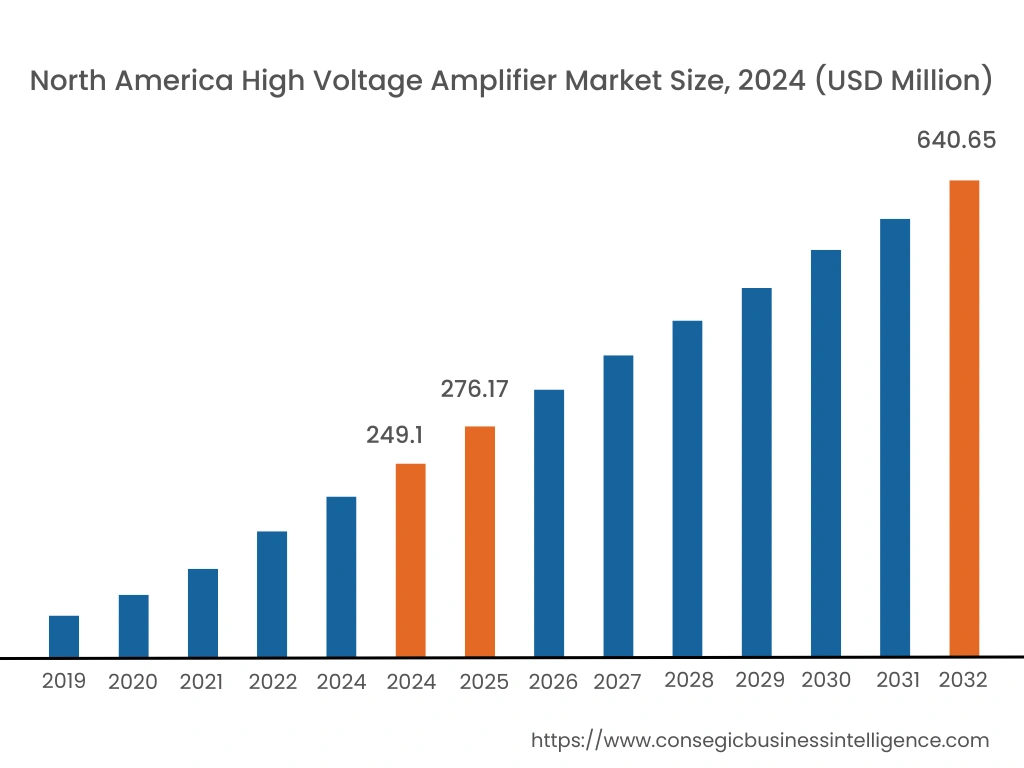
North America is estimated to reach over USD 640.65 Million by 2032 from a value of USD 249.1 Million in 2024 and is projected to grow by USD 276.17 Million in 2025. In addition, in the region, the U.S. accounted for the maximum revenue share of 66.40% in the same year. The adoption of high voltage amplifiers in North America is primarily driven by the high demand for wireless communication systems, as well as the presence of key players including Analog Technologies, Inc., Analog Devices, Inc., Microchip Technology Inc. Additionally, the growing military requirements and the growth of the automotive sector in the region are driving the market growth for high voltage amplifiers.
North America is also a hub for defense & military equipment, which use high voltage amplifiers to transmit and receive signals. The increasing demand for radar systems in defense and security applications is driving the demand for high voltage amplifiers. Furthermore, the companies located in the region have a strong research and development (R&D) presence and invest heavily in new technologies, which is helping to drive the growth of the high voltage amplifiers market in the region.
Moreover, Asia-Pacific is expected to register the fastest CAGR growth of 13.1% during the forecast period. The high voltage amplifier market in the Asia-Pacific region is expected to grow significantly during the forecast period. This growth is attributed to a number of factors, including rapidly growing communication infrastructure, strong demand from the automotive sector, and government initiatives to boost the industrial infrastructure. The automotive sector utilizes various components in vehicles and is installed with telematics systems, radar systems, and Bluetooth systems, among others. Therefore, owing to the growing requirements from the aforementioned sectors is projected to fuel the market growth of high voltage amplifiers during the forecast period.
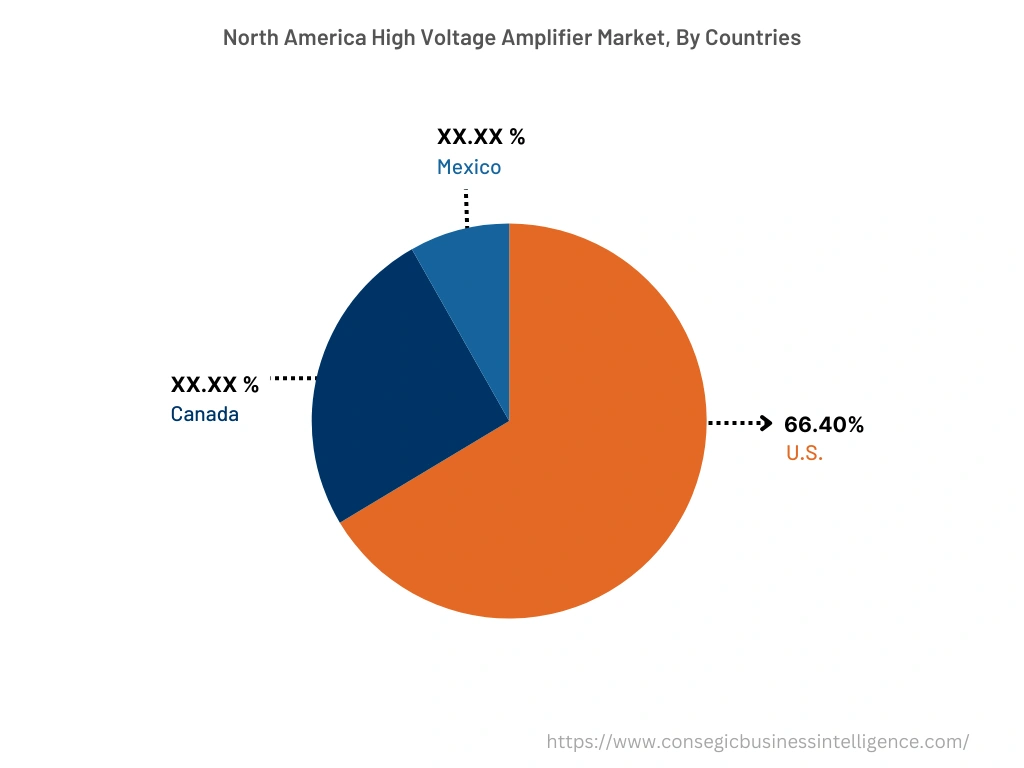
Top Key Players & Market Share Insights:
The High Voltage Amplifier market is highly competitive with major players providing High Voltage Amplifiers to the national and international markets. Key players are adopting several strategies in research and development (R&D), product innovation, and end use launches to hold a strong position in High Voltage Amplifier market. Key players in the High Voltage Amplifier market include-
- Analog Technologies, Inc.
- Analog Devices, Inc.
- Jiangsu Runic Technology Co., Ltd.
- Apex Microtechnology, Inc.
- Tabor Electronics Ltd.
- Acquitek
- Microchip Technology Inc.
- Nisshinbo Micro Devices Inc.
- STMicroelectronics
- Texas Instruments
- hivolt.de GmbH & Co. KG
Recent Industry Developments :
- In February 2021, STMicroelectronics launched three precision high-voltage bi-directional current-sense amplifiers, namely TSC2010, TSC2011, and TSC2012.
Key Questions Answered in the Report
What is High Voltage Amplifier? +
High voltage amplifier is a device utilized for voltage signal amplification. The device is designed for providing higher voltage output that often underlie within the voltage range greater than 10V and exceed to 100V or more.
What specific segmentation details are covered in the high voltage amplifier report, and how is the dominating segment impacting the market growth? +
For instance, by type segment has witnessed bipolar as the dominating segment in the year 2024, owing to its increasing demand from industries including automotive, telecommunication, and others.
What specific segmentation details are covered in the high voltage amplifier market report, and how is the fastest segment anticipated to impact the market growth? +
For instance, by end use segment will witness telecommunication segment to grow at the fastest growth rate during the forecast period. The rising demand for improved devices that are able to communicate more efficiently with other handheld or stationary devices is expected to boost the market growth during the forecast period.
Which region/country is anticipated to witness the highest CAGR during the forecast period, 2025-2032? +
Asia-Pacific is anticipated to register fastest CAGR growth of 13.1% during the forecast period due to rapid pace of industrialization and demand for improved telecommunication infrastructure.
